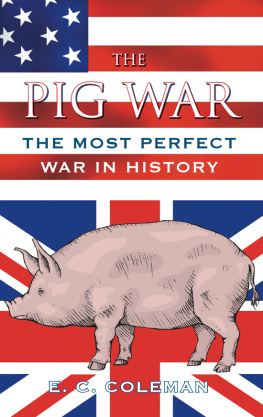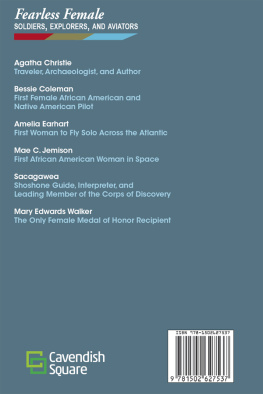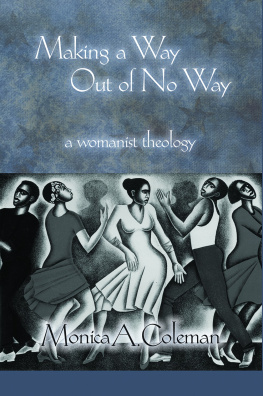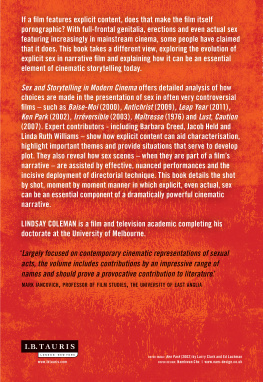E. C. Coleman - The Pig War
Here you can read online E. C. Coleman - The Pig War full text of the book (entire story) in english for free. Download pdf and epub, get meaning, cover and reviews about this ebook. year: 2013, publisher: The History Press, genre: History. Description of the work, (preface) as well as reviews are available. Best literature library LitArk.com created for fans of good reading and offers a wide selection of genres:
Romance novel
Science fiction
Adventure
Detective
Science
History
Home and family
Prose
Art
Politics
Computer
Non-fiction
Religion
Business
Children
Humor
Choose a favorite category and find really read worthwhile books. Enjoy immersion in the world of imagination, feel the emotions of the characters or learn something new for yourself, make an fascinating discovery.
- Book:The Pig War
- Author:
- Publisher:The History Press
- Genre:
- Year:2013
- Rating:5 / 5
- Favourites:Add to favourites
- Your mark:
- 100
- 1
- 2
- 3
- 4
- 5
The Pig War: summary, description and annotation
We offer to read an annotation, description, summary or preface (depends on what the author of the book "The Pig War" wrote himself). If you haven't found the necessary information about the book — write in the comments, we will try to find it.
The Pig War — read online for free the complete book (whole text) full work
Below is the text of the book, divided by pages. System saving the place of the last page read, allows you to conveniently read the book "The Pig War" online for free, without having to search again every time where you left off. Put a bookmark, and you can go to the page where you finished reading at any time.
Font size:
Interval:
Bookmark:
THE
PIG WAR
THE
PIG WAR
THE MOST PERFECT
WAR IN HISTORY
E. C. COLEMAN

First published 2009
The History Press
The Mill, Brimscombe Port
Stroud, Gloucestershire, GL 5 2 QG
www.thehistorypress.co.uk
This ebook edition first published in 2013
All rights reserved
E.C. Coleman 2009, 2013
The right of E.C. Coleman to be identified as the Author of this work has been asserted in accordance with the Copyrights, Designs and Patents Act 1988.
This ebook is copyright material and must not be copied, reproduced, transferred, distributed, leased, licensed or publicly performed or used in any way except as specifically permitted in writing by the publishers, as allowed under the terms and conditions under which it was purchased or as strictly permitted by applicable copyright law. Any unauthorised distribution or use of this text may be a direct infringement of the authors and publishers rights, and those responsible may be liable in law accordingly.
EPUB ISBN 978 0 7524 9670 2
Original typesetting by The History Press

Contents

A New Nation Flexes its Muscles
On the obverse of the Great Seal of the United States of America, a spread-winged bald eagle clutches in one of its talons an olive branch; in the other, thirteen arrows. The eagles body is hidden behind a shield, whilst above its head a circle of light-emitting clouds enclose thirteen stars. A ribbon streams from the birds beak, bearing the words e pluribus unum (out of many, one). It is a fine indeed, noble image that threatens firm retaliation, but offers peace.
The reverse of the seal shows a quite different design. The main feature is an unfinished pyramid with its top layers and cap missing. As if to take the place of the missing section, a matching triangle, containing a light-emitting eye, hovers just above the incomplete structure. Above the design, a Latin motto reads annuit coeptis, which is usually translated as God has favoured our undertaking. Along the bottom another Latin motto states novus ordo seclorum, which is taken to mean a new order for the world (or of the ages). Taken together, however, the mottos can be read as grant the beginning of a new world order.
The fathers of the American Revolution were not long in attempting to set the beginning of this new world order in motion. Dr Benjamin Franklin, who was the leading designer of the unfinished pyramid of the Great Seal, had the following as the thirteenth of his Articles of Confederation of 21 July 1775:
Any and every colony from Great Britain upon the continent of North America and not at present engagd in our Association shall upon Application and joining the said Association be receivd into this Confederation, viz. West India Islands, Quebec, St Johns, Nova Scotia, Bermudas, and East and West Florida; and shall thereupon be entitled to all the Advantages of our Union, mutual Assistance and Commerce.
As the negotiations for the recognition of the United States began in September 1782, the American side (John Adams, Benjamin Franklin and John Jay) began by demanding that Great Britain surrender Canada (then consisting of the two colonies of Upper and Lower Canada) to the United States. It was a bold thrust that would have set the missing cap onto the pyramid. The British negotiator, David Hartley, backed by the Prime Minister, rejected the suggestion with such vigour that it quickly became clear to the Americans that to continue with such an outrageous demand would jeopardise the whole negotiation and risk subjecting the fledgling nation to an unwanted continuation of hostilities. Consequently, the national border between Canada and the United States, fishing and property rights, and the withdrawal of the British from American soil were all negotiated and settled. The northern border of the United States would, it was agreed, reach from the Atlantic, through the Great Lakes, to the most northwesternmost point of the Lake of the Woods, and thence on a due west course to the River Mississippi. The principle, however, of obtaining all the land in North America for the United States had taken root, and so began the longest cold war in history: that between the United States and Great Britain.
Beyond the Mississippi, Louisiana the land as far west as the Rockies had belonged to the Spanish since 1763, when it was taken from the French. In 1801, by treaty, France regained control of Louisiana and, as a result, the United States found itself staring at a golden opportunity. By the end of that year, the French Revolutionary War had fought itself to a stand-still. Both France and Britain were exhausted. The Royal Navy dominated the seas, while the French Army, under Napoleon Bonaparte, continued to grow more powerful. But a larger, more powerful army is expensive, and Napoleon was keen to raise the necessary funds. The Treaty of Amiens, signed in 1802, provided a pause in the conflict, but Britain had not done well out of the treaty and, when the French began to disregard parts of the agreement, Britain refused to abandon Malta and began an aggressive blockade against French shipping. In this atmosphere, the Americans approached Napoleon with a remarkable suggestion. They would like to buy part of Louisiana. The bait worked. The French offered not just a part, but all of Louisiana, in return for which the United States would pay 60 million francs and cancel 20 million francs worth of debt (a total of $15 million). At a stroke, the French economy was raised to a war footing, the Americans had doubled the size of their country and the British were, once again, embroiled in a continental war.
As the combatants took up their positions, the Americans could afford to await the outcome. If the British came out on top, nothing would have changed; but if the British were defeated, it would be an easy task to walk into their possessions in North America and take them over.
Across the Atlantic, the war had taken on a significant change on its resumption. The Royal Navy, especially after Nelsons great victory at Trafalgar, continued to sweep all before it, but the British Army was occupied in removing the French from Spain. By 1812, the United States of America felt it could make moves of its own. It did not have to look far for an excuse. As far back as 1807 an incident had occurred which had threatened to bring the Americans into the war.
Against a background of blockading that had badly affected American trade, the Royal Navy insisted on continuing its practice of raising men by pressing them into the service. In Britain itself, any man used to the sea was at risk of being pressed. There were exemptions, but being on board a foreign vessel was not one of them. Many seamen had deserted to American ships, usually for the better rates of pay rather than for any greater principle. Consequently, the Royal Navy assumed the right to stop any American ship and to search it for His Majestys subjects who would be better employed in the ships of war of their own nation or hanged as an example if desertion could be proved.
On 22 June 1807, Captain Humphreys of HMS Leopard sent a boat across to the USS Chesapeake with a demand that Humphreys men be allowed to search her for British seamen. Captain Barron of the Chesapeake refused the demand and was seen by the men in the Leopards boat to be preparing for battle. On learning of the Americans action, Humphreys promptly gave the order to engage the Chesapeake. Within minutes, three Americans had been killed, eighteen had been injured and the British were searching their ship.
Next pageFont size:
Interval:
Bookmark:
Similar books «The Pig War»
Look at similar books to The Pig War. We have selected literature similar in name and meaning in the hope of providing readers with more options to find new, interesting, not yet read works.
Discussion, reviews of the book The Pig War and just readers' own opinions. Leave your comments, write what you think about the work, its meaning or the main characters. Specify what exactly you liked and what you didn't like, and why you think so.












